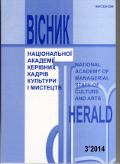THE INDICATION OF VERISM IN OPERATIC CREATIVE ACTIVITY OF TAN DUN
DOI:
https://doi.org/10.32461/2226-3209.3.2014.138120Keywords:
vеrism, style, genre, parallelisms of the development of the cultures of the Orient and West, opera, pаssiоnAbstract
Work is dedicated to discovery веристского building thinkings type of verism of Tan Dun as that stylistic ambience, which is approved success chinese musician-performers and is prepared to contact with art of the Orient by creative activity J. Puccini. In the highlight – an opera Tan Duna "First emperor", in original composition which
perceptible evident parallels to "Turandot" Dzh. Puchchini.
The Main conflict of the opera – an opposition of the Emperor and Gao Janli, in opera Tan Duna both mains hero participate report in both acts of the operatic presentation. Such sort parity register – related old-time european
opera, however inherent given composition chinese-american composer dramatic effect impossible for opera-fairy talesparables XVII age. Tan Dun used the concept of the history drama, approved dramaturgy of qingqiung, has however selected the lyric poet-mеlоdical expression, coming from tradition kunqiug, became popular in USA in 2000-e years.
In european tradition specified join tenor sonorousness creates the person of the sort power vibration United since iron will of the Emperor and chivalrous courage of the Musician there is Glory State, which to define by blood and
self-sacrifice of chinese folk. All are terminated by majestic hymn, which sing the slaves on construction Great chinese wall, objective protected state-nation and pawned his greatness in histories on age, up to present-day day.
The Specified completion "First emperor" Tan Dun reminds the termination "Turandot" J. Puccini, in which main
hero also break through self-sacrifice Liu pour as natural step to improvement themselves itself and encirclements. Clear that victim of the First emperor more grandiose and does not contain that justifications by love, which so conquers the conventionality Wonder in finale "Turandot". In opera frankly mortgaged idea-structure of passion, only with "change" persona-organizers of offering: possessing power Jude, he Emperor, solves the fate a Creator, line which beside Gao, betraying confidence of the friendship and purity related feeling. On passion type are built two actions of the opera (has obviously operated the experience of the work on "Passion – 2000": I act – prepare of offering ("secret evening of" Emperor, solving donate other and daughter for the sake of state Order), II act – a realization of offering, presented setting ritual actions of shaman, sanctifying exultant Order of the final glad ascent.
Verism composed of operas Tan Dun come to light on lines of the join sings of mystery and strictly operatic action. It is emphasized ritualism of action of the heroes, complying with call honor – a State serving, Moral responsibillity, Self-sacrifices in salvation of choice.
Register correlation with вухфазностью of the passion development in two phases exceedingly significative and
for classicists verism operas-short stories, in one- or two аcts, in three acts in Puccini, but with obligatory two phase – prepare of offering and fulfilment her.
Downloads
Published
Issue
Section
License
Authors who publish with this journal agree to the following terms:
1. Authors retain copyright and grant the journal right of first publication with the work simultaneously licensed under a Creative Commons Attribution License that allows others to share the work with an acknowledgement of the work's authorship and initial publication in this journal.
2. Authors are able to enter into separate, additional contractual arrangements for the non-exclusive distribution of the journal's published version of the work (e.g., post it to an institutional repository or publish it in a book), with an acknowledgement of its initial publication in this journal.
3. Authors are permitted and encouraged to post their work online (e.g., in institutional repositories or on their website) prior to and during the submission process, as it can lead to productive exchanges, as well as earlier and greater citation of published work (See The Effect of Open Access).


